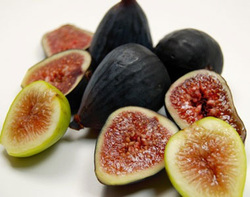
The fig tree (Ficus carica) is the result of a majestic plant, native to the Mediterranean area.
It is believed that the fig tree is native of 'Asia, but according to other sources, however, its origin is placed in the Middle East. In any case, surely its origin is very old. In the Bible, for example, is cited as the first "dress" of the story: Adam and Eve "dressed" in fact, of fig leaves. In the Old Testament, the fig is mentioned as a symbol of abundance. In India, the banyan tree is considered sacred, and the plant is called Ficus Religious. In Greece the fig tree was involved in many myths, especially of an erotic nature, they also saw it as a sacred tree, and attributed to the god Dionysus, the birth of this tree. It is said that Polyphemus used the juice produced from the fig to coagulate the milk and produce cheese in his cave. Aristotle documented fact, in one of his writings, both techniques clotting milk : the coagulation of animal origin and the one with fig juice . Plato was a great lover of figs, and for this reason he was given the name of "eater of figs." Also recommended to eat this fruit because according to him, helped to strengthen the intelligence. For the Romans, the fig tree, was a sacred plant as the vine and the olive tree: it is said that during the New Year holidays, as a wish for a happy and prosperous year, they used to give to family and friends, honey and fig fruits. Pliny claimed that eating figs "makes us stronger young people, helps the health of the elderly, and reduces wrinkles." Also the Phoenicians and Etruscans, are among the oldest populations feeding on figs.
Roses of figs
If you have fresh figs, take them, rinse and dry it with a soft cloth and gently wipe the outside. Cut into 4 equal parts but without dividing the base (as in the photograph), then open them gently like a flower has four petals and formed with each slice of prosciutto ham a rose, which will place the center of each fig.
It is believed that the fig tree is native of 'Asia, but according to other sources, however, its origin is placed in the Middle East. In any case, surely its origin is very old. In the Bible, for example, is cited as the first "dress" of the story: Adam and Eve "dressed" in fact, of fig leaves. In the Old Testament, the fig is mentioned as a symbol of abundance. In India, the banyan tree is considered sacred, and the plant is called Ficus Religious. In Greece the fig tree was involved in many myths, especially of an erotic nature, they also saw it as a sacred tree, and attributed to the god Dionysus, the birth of this tree. It is said that Polyphemus used the juice produced from the fig to coagulate the milk and produce cheese in his cave. Aristotle documented fact, in one of his writings, both techniques clotting milk : the coagulation of animal origin and the one with fig juice . Plato was a great lover of figs, and for this reason he was given the name of "eater of figs." Also recommended to eat this fruit because according to him, helped to strengthen the intelligence. For the Romans, the fig tree, was a sacred plant as the vine and the olive tree: it is said that during the New Year holidays, as a wish for a happy and prosperous year, they used to give to family and friends, honey and fig fruits. Pliny claimed that eating figs "makes us stronger young people, helps the health of the elderly, and reduces wrinkles." Also the Phoenicians and Etruscans, are among the oldest populations feeding on figs.
Roses of figs
If you have fresh figs, take them, rinse and dry it with a soft cloth and gently wipe the outside. Cut into 4 equal parts but without dividing the base (as in the photograph), then open them gently like a flower has four petals and formed with each slice of prosciutto ham a rose, which will place the center of each fig.

 RSS Feed
RSS Feed